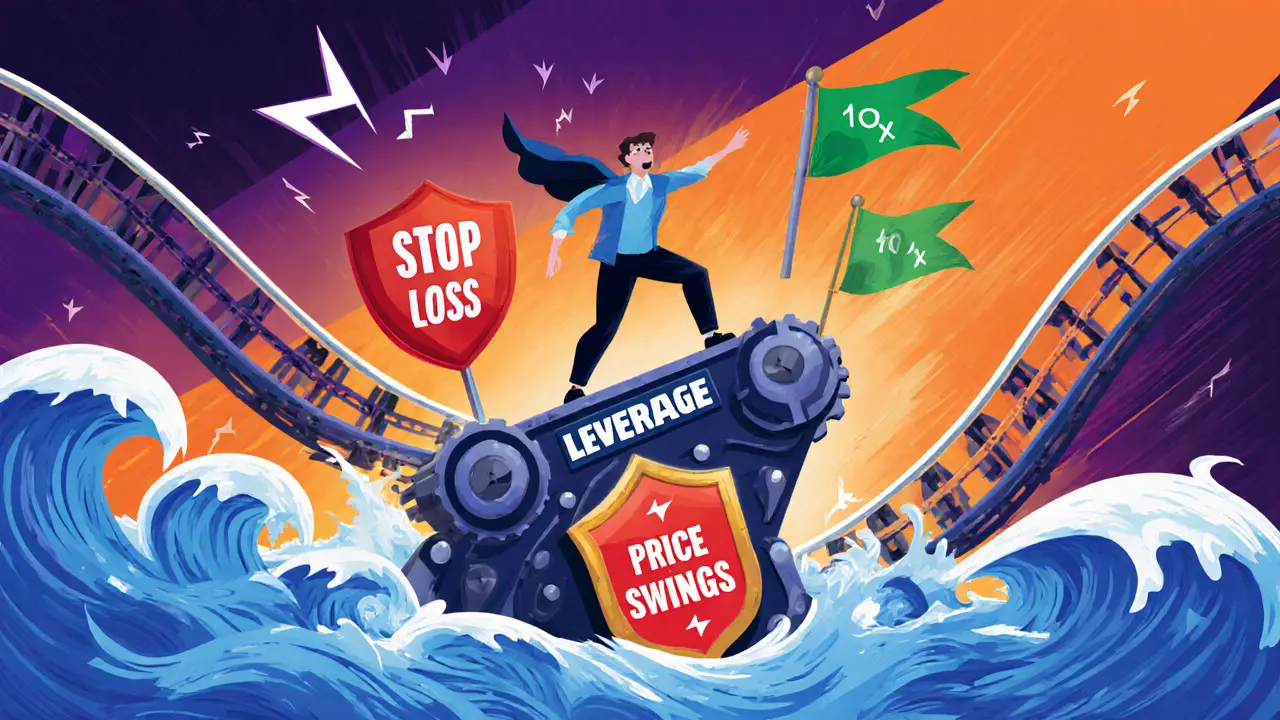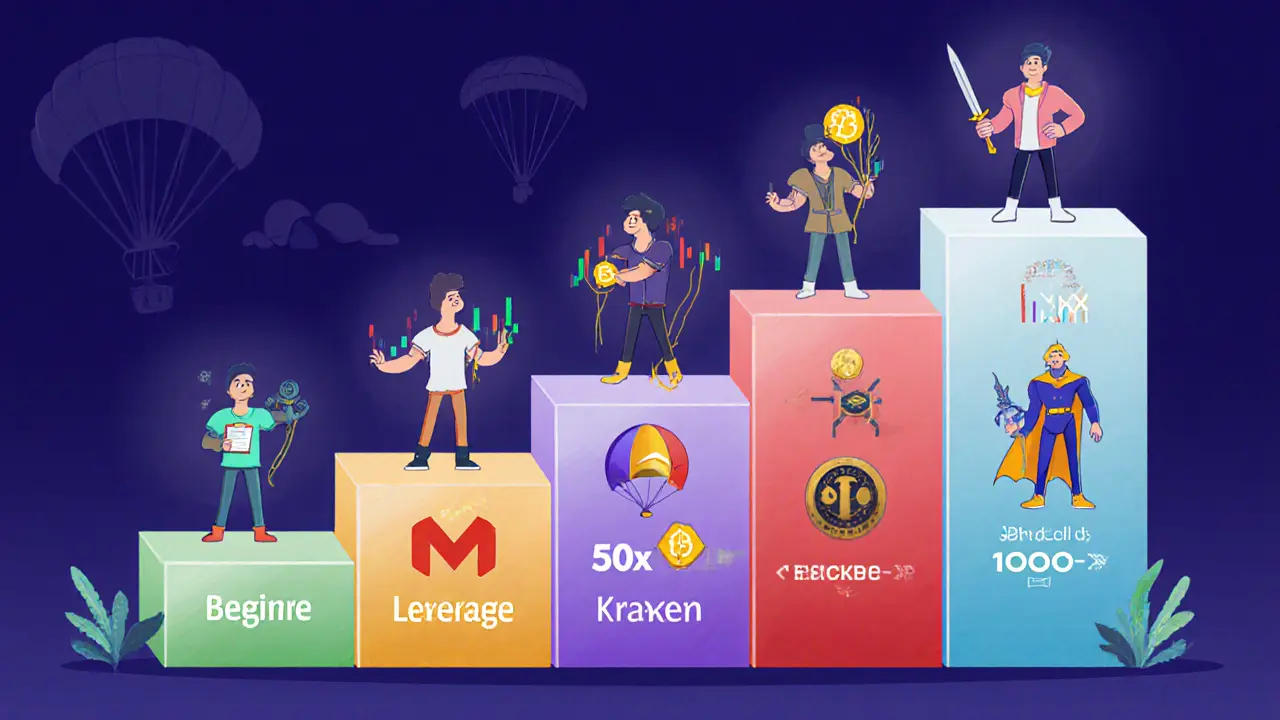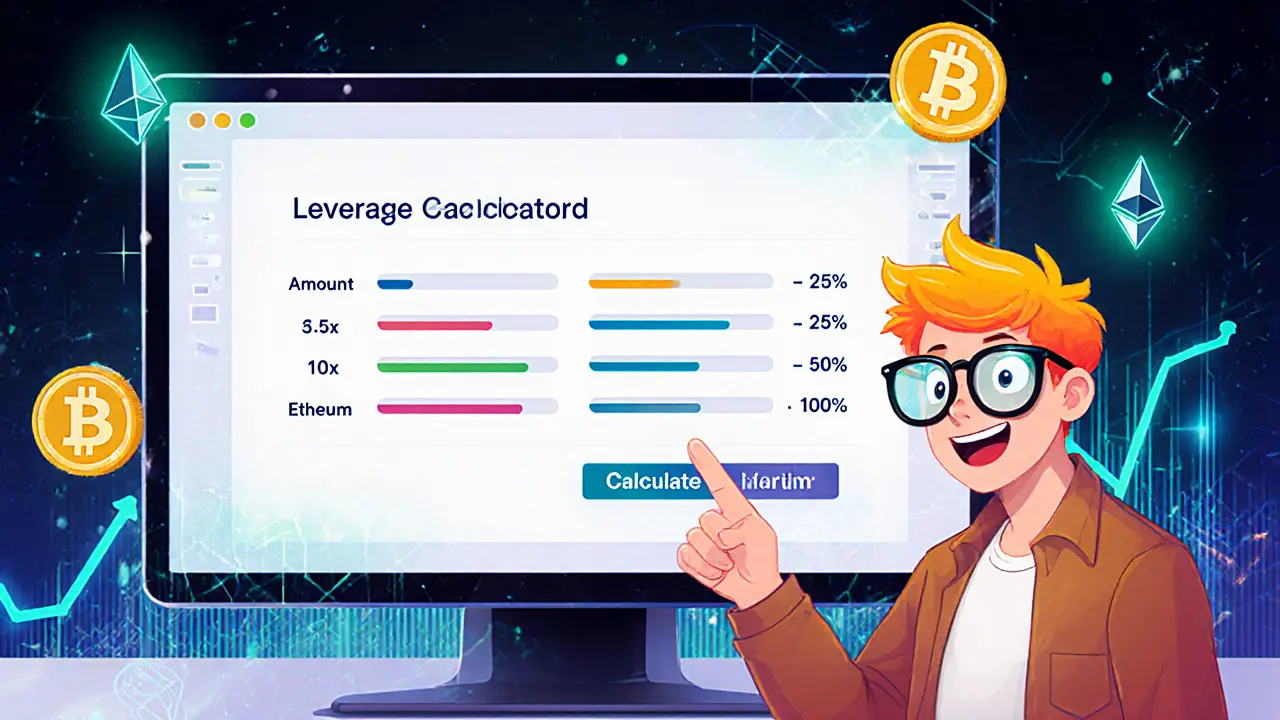Crypto Leverage Calculator
Results
Enter values and click Calculate to see your potential outcomes.
Ever wondered why a tiny price swing can wipe out a whole crypto account? The culprit is cryptocurrency leverage - a tool that lets you control big positions with little cash, but also magnifies losses. This guide breaks down the math, the risks, and the practical steps you need to trade 10x, 50x, or even 100x safely.
TL;DR - What You Need to Know
- 10x leverage means you put up 10% of the trade value; a 5% move equals 50% on your margin.
- 50x leverage trims margin to 2%; a 2% move can double or erase your stake.
- 100x leverage requires just 1% margin; a 1% adverse move triggers liquidation.
- Risk management tools (stop‑loss, take‑profit, partial liquidation) are non‑negotiable at high ratios.
- Start low (2x‑5x), master spot trading, then only step up after consistent profits.
How Leverage Works in Crypto
At its core, leverage is a loan from an exchange. You deposit a margin the collateral required to open a leveraged position and the platform lends you the rest.
The ratio is written as X:1 (e.g., 10:1) or simply “10x”. The first number tells you the total exposure, the second tells you the portion you actually own. For a $1,000 deposit with 10x, you control $10,000 of Bitcoin. The same $1,000 at 100x would control $100,000.
Two forces drive the outcome:
- Multiplier effect: profits and losses are scaled by the leverage factor.
- Liquidation the forced closing of a position when margin falls below a maintenance threshold: the exchange closes your trade to prevent a negative balance.
Math Behind 10x, 50x, and 100x
Understanding the numbers removes a lot of guesswork.
| Leverage | Margin Required | Price Move for 100% Return | Price Move for Liquidation |
|---|---|---|---|
| 10x | 10% | 10% favorable move | 10% adverse move |
| 50x | 2% | 2% favorable move | 2% adverse move |
| 100x | 1% | 1% favorable move | 1% adverse move |
Notice how the required margin shrinks as the leverage climbs, but the cushion against loss also vanishes. A 5% swing that would be a modest 50% gain at 10x becomes a 500% gain‑or‑loss at 100x.
Risk Management That Actually Works
High leverage is a double‑edged sword; the only way to keep it from cutting you out is disciplined risk control.
- Stop‑loss orders: set a price where the platform automatically closes your position. Many traders place stops at 1‑2% for 100x trades.
- Take‑profit levels: lock in gains before a market reversal erases them.
- Position sizing: never risk more than 1‑2% of your total account on a single trade, regardless of leverage.
- Partial liquidation (offered by Binance, Kraken, etc.): the exchange trims part of your position instead of wiping you out, buying you more time.
- Dynamic leverage: some platforms let you lower the ratio mid‑trade as volatility spikes.
Combine these tools with a clear risk‑reward ratio (e.g., aim for at least 2:1). Even seasoned traders lose money when they ignore the basics.

Choosing the Right Leverage for Your Skill Level
There's no one‑size‑fits‑all answer. Here’s a quick guide:
- Beginner (new to spot & technical analysis): stick to 2x‑5x. It teaches margin discipline without exposing you to instant liquidation.
- Intermediate (consistent spot profits, basic risk tools): 10x is a sweet spot. You get meaningful amplification while still having a safety net.
- Advanced (track record of profitable trades, strong risk framework): dabble with 25x‑50x on high‑confidence setups. Reserve 100x for very short‑term scalps on low‑volatility markets.
- Professional / Institutional: use 100x only if you have hedging mechanisms, automated monitoring, and deep liquidity.
Platform Comparison - Where to Trade Leverage
Not all exchanges are created equal. Below are the most popular options for the three ratios.
| Exchange | Max Leverage Offered | Mode (Isolated / Cross) | Risk Tools | Regulatory Notes |
|---|---|---|---|---|
| Binance | 100x (Bitcoin), 125x (some altcoins) | Isolated | Stop‑loss, take‑profit, partial liquidation | Subject to EU 2x cap for retail; higher ratios for non‑EU users |
| Kraken | 100x | Isolated & Cross | Advanced stop orders, dynamic leverage | Requires KYC; complies with US AML rules |
| BTSE | 100x | Isolated (except Cross mode) | Take‑profit, stop‑loss, liquidation alerts | Operates under Malta licence, offers education hub |
When picking a platform, prioritize clear fee structures, reliable margin calls, and solid educational resources.
Real‑World Examples
Example 1 - 10x in a Trending Market
You spot Bitcoin climbing from $30,000 to $31,500 (5% rise). With 10x leverage, you deposit $1,000, control $10,000 worth of BTC, and earn $500 (5%×10). Your margin stays healthy because the price moved in your favor.
Example 2 - 50x Gone Wrong
You enter a $30,000 BTC position using 50x, needing $600 margin for a $30,000 exposure of $30,000×50=$1.5M? (Simplify: $600 controls $30,000). A sudden 2% dip to $29,400 wipes out your $600, triggering liquidation.
Example 3 - 100x Scalping
You trade a low‑volatility altcoin that usually moves ≤0.5% per minute. You go 100x with a $2,000 deposit, set a stop‑loss at -0.8% and a take‑profit at +0.8%. If the price moves +0.8% instantly, you net $1,600 profit (80% of your margin). If it slips -0.8%, you lose the whole $2,000.
These snapshots illustrate why the same leverage can feel like a turbo boost or a landmine.
Common Pitfalls to Avoid
- Assuming higher leverage equals higher profit - the position size stays the same; you only reduce the cash needed.
- Neglecting funding rates - long positions can incur periodic fees that eat profits.
- Using “cross” mode without full‑account awareness - a loss in one trade can drain all your capital.
- Trading during extreme volatility (e.g., news spikes) without tighter stops.
- Relying solely on platform calculators without manual verification.
Next Steps - From Theory to Practice
1. Master Spot Trading: learn chart patterns, support/resistance, and order types.
2. Open a Demo Account on Binance or Kraken and practice isolated 2x‑5x trades.
3. Calculate Your Breakeven using the exchange’s leverage calculator. Verify the liquidation price manually.
4. Set Strict Risk Rules: max 2% account risk per trade, stop‑loss at 1‑2% price move, take‑profit at least double that.
5. Gradually Increase Leverage only after you achieve a 3‑month streak of >60% win‑rate on low‑leverage trades.

Frequently Asked Questions
What does 10x leverage actually mean?
A 10x leverage ratio means you only need 10% of the trade’s total value as margin. The exchange loans you the remaining 90%, so a $1,000 deposit can control a $10,000 position.
How is liquidation price calculated?
Liquidation occurs when your equity falls below the maintenance margin. For 50x leverage, the maintenance margin is typically around 0.5% of the position. If you opened a $10,000 trade with $200 margin, a 2% adverse move reduces equity to $0, triggering the exchange to close the position.
Is 100x leverage suitable for beginners?
Almost never. The margin buffer is only 1%, so a 1% price swing wipes the account. Most experts recommend starting with 2x‑5x until you can consistently profit on spot markets.
Can I use leverage on any cryptocurrency?
Most major exchanges offer leverage on Bitcoin, Ethereum, and a handful of liquid altcoins. Less‑traded tokens often have lower or no leverage due to insufficient market depth.
What tools help manage risk on high‑leverage trades?
Stop‑loss and take‑profit orders, partial liquidation, dynamic leverage adjustments, and real‑time margin alerts are essential. Many traders also set up external monitoring bots for added safety.


Anurag Sinha
The moment they let you 100x, the whales start pulling strings from the shadows.